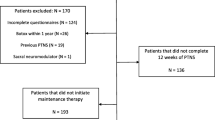Abstract
Purpose
To evaluate long-term use, efficacy and tolerability of transcutaneous tibial nerve stimulation (TTNS) in the treatment of refractory overactive bladder (OAB).
Methods
We performed a prospective observational study and included all patients treated in a single center for OAB persisting after first-line anticholinergic treatment, with ≥ 24 months follow-up. The protocol consisted of daily stimulation at home. The primary outcome was treatment persistence. Amelioration was defined as an improvement in urinary symptom profile (USP) score.
Results
We assessed 84 consecutive patients. After a mean follow-up of 39.3 months and a mean treatment use of 8.3 months, almost two-thirds of patients (71.8%) had discontinued TTNS. Treatment continuation was > 12 months for 28 patients (33.3%) and > 18 months for 16 patients (19%). TTNS was successful following 3 months of treatment in 60 (71%) patients. Mean USP score stayed significantly lower than baseline until 12 months of treatment, but was not significant anymore after 18 months. Discontinuation therapy reasons were a lack of sufficient symptom relief for 59 (70%) patients, compliance difficulty for 5 (6%) patients and becoming asymptomatic for 6 (8%) patients. No serious adverse events occurred.
Conclusions
The present study confirms the utility of TTNS as a treatment option for patients with resistant OAB. In the long-term use, few patients continued with therapy, mostly because of a decreased effectiveness with time.


Similar content being viewed by others
References
Haylen BT, de Ridder D, Freeman RM et al (2010) An International Urogynecological Association (IUGA)/International Continence Society (ICS) joint report on the terminology for female pelvic floor dysfunction. Neurourol Urodyn 29:4–20. https://doi.org/10.1002/nau.20798
Irwin DE, Milsom I, Hunskaar S et al (2006) Population-based survey of urinary incontinence, overactive bladder, and other lower urinary tract symptoms in five countries: results of the EPIC study. Eur Urol 50:1306–1315
Madhuvrata P, Cody JD, Ellis G et al (2012) Which anticholinergic drug for overactive bladder symptoms in adults. Cochrane Database Syst Rev 1:CD005429. https://doi.org/10.1002/14651858.cd005429.pub2
D’Souza AO, Smith MJ, Miller L-A et al (2008) Persistence, adherence, and switch rates among extended-release and immediate-release overactive bladder medications in a regional managed care plan. J Manag Care Pharm JMCP 14:291–301
Abrams P, Andersson KE, Birder L et al (2010) Fourth international consultation on incontinence recommendations of the international scientific committee: evaluation and treatment of urinary incontinence, pelvic organ prolapse, and fecal incontinence. Neurourol Urodyn 29:213–240. https://doi.org/10.1002/nau.20870
Zinkgraf K, Quinn AO, Ketterhagen D et al (2009) Percutaneous tibial nerve stimulation for treatment of overactive bladder and urinary retention in an elderly population. Urol Nurs 29:30–34
Stewart F, Gameiro LF, El Dib R et al (2016) Electrical stimulation with non-implanted electrodes for overactive bladder in adults. Cochrane Database Syst Rev 12:CD010098. https://doi.org/10.1002/14651858.cd010098.pub4
Haab F, Richard F, Amarenco G et al (2008) Comprehensive evaluation of bladder and urethral dysfunction symptoms: development and psychometric validation of the urinary symptom profile (USP) questionnaire. Urology 71:646–656. https://doi.org/10.1016/j.urology.2007.11.100
De Sèze M, Raibaut P, Gallien P et al (2011) Transcutaneous posterior tibial nerve stimulation for treatment of the overactive bladder syndrome in multiple sclerosis: results of a multicenter prospective study. Neurourol Urodyn 30:306–311. https://doi.org/10.1002/nau.20958
Ammi M, Chautard D, Brassart E et al (2014) Transcutaneous posterior tibial nerve stimulation: evaluation of a therapeutic option in the management of anticholinergic refractory overactive bladder. Int Urogynecol J 25:1065–1069. https://doi.org/10.1007/s00192-014-2359-0
Schreiner L, dos Santos TG, Knorst MR, da Silva Filho IG (2010) Randomized trial of transcutaneous tibial nerve stimulation to treat urge urinary incontinence in older women. Int Urogynecol J 21:1065–1070. https://doi.org/10.1007/s00192-010-1165-6
Govier FE, Litwiller S, Nitti V et al (2001) Percutaneous afferent neuromodulation for the refractory overactive bladder: results of a multicenter study. J Urol 165:1193–1198
Klingler HC, Pycha A, Schmidbauer J, Marberger M (2000) Use of peripheral neuromodulation of the S3 region for treatment of detrusor overactivity: a urodynamic-based study. Urology 56:766–771
Vandoninck V, van Balken MR, Finazzi Agrò E et al (2003) Percutaneous tibial nerve stimulation in the treatment of overactive bladder: urodynamic data. Neurourol Urodyn 22:227–232. https://doi.org/10.1002/nau.10111
Peters KM, MacDiarmid SA, Wooldridge LS et al (2009) Randomized trial of percutaneous tibial nerve stimulation versus extended-release tolterodine: results from the overactive bladder innovative therapy trial. J Urol 182:1055–1061. https://doi.org/10.1016/j.juro.2009.05.045
Peters KM, Carrico DJ, Wooldridge LS et al (2013) Percutaneous tibial nerve stimulation for the long-term treatment of overactive bladder: 3 years results of the STEP study. J Urol 189:2194–2201. https://doi.org/10.1016/j.juro.2012.11.175
Amarenco G, Ismael SS, Even-Schneider A et al (2003) Urodynamic effect of acute transcutaneous posterior tibial nerve stimulation in overactive bladder. J Urol 169:2210–2215. https://doi.org/10.1097/01.ju.0000067446.17576.bd
Hashim H, Beusterien K, Bridges JFP et al (2015) Patient preferences for treating refractory overactive bladder in the UK. Int Urol Nephrol 47:1619–1627. https://doi.org/10.1007/s11255-015-1100-3
Souto SC, Reis LO, Palma T et al (2014) Prospective and randomized comparison of electrical stimulation of the posterior tibial nerve versus oxybutynin versus their combination for treatment of women with overactive bladder syndrome. World J Urol 32:179–184. https://doi.org/10.1007/s00345-013-1112-5
Author information
Authors and Affiliations
Contributions
Author contributions
P-AL: data collection and analysis, and manuscript writing/editing. EB: project development and data collection. SL: manuscript editing. ARA: project development. PB: project development, manuscript editing and data analysis. JC: data analysis and manuscript writing/editing
Corresponding author
Ethics declarations
Conflict of interest
The authors declare that they have no conflict of interest.
Ethical approval
All procedures performed in studies involving human participants were in accordance with the ethical standards of the institutional and/or national research committee and with the 1964 Helsinki Declaration and its later amendments or comparable ethical standards.
Informed consent
Informed consent was obtained from all individual participants included in the study.
Rights and permissions
About this article
Cite this article
Leroux, PA., Brassart, E., Lebdai, S. et al. Transcutaneous tibial nerve stimulation: 2 years follow-up outcomes in the management of anticholinergic refractory overactive bladder. World J Urol 36, 1455–1460 (2018). https://doi.org/10.1007/s00345-018-2296-5
Received:
Accepted:
Published:
Issue Date:
DOI: https://doi.org/10.1007/s00345-018-2296-5




